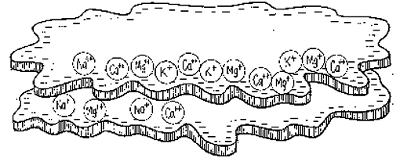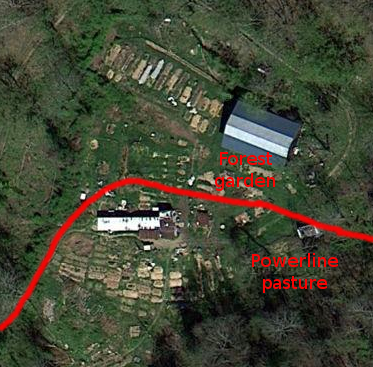
Clay, humus, and CEC
 I've been writing about how
organic matter increases your cation
exchange capacity (CEC), but, while that's true, there's more to
the story. Clay also increases your CEC, and some clays have a
higher CEC than others. A very young clay has a low CEC,
middle-aged clays can have a CEC as high as 100, and very old clays
have filled up all of those negatively charged sites with hydrated
aluminum oxide and have a CEC as low as 5.
I've been writing about how
organic matter increases your cation
exchange capacity (CEC), but, while that's true, there's more to
the story. Clay also increases your CEC, and some clays have a
higher CEC than others. A very young clay has a low CEC,
middle-aged clays can have a CEC as high as 100, and very old clays
have filled up all of those negatively charged sites with hydrated
aluminum oxide and have a CEC as low as 5.
A good way to figure out
what kind of clay you have is to dig down to your subsoil and do a
separate test of that ground. (This only works if you live in an
area wet enough that the subsoil is clay.) I didn't perform a
separate subsoil test, but both the soil I pulled out of the powerline
pasture terrace and the soil in the forest
garden aisles is
pretty low in organic matter and pretty high in clay, so I thought I'd
take a look:
| Powerline pasture | Forest aisles | |
| CEC | 7.65 | 6.2 |
| pH | 5.1 | 6.3 |
| %OM | 2.74 | 5.43 |
| S | 30 | 40 |
| P | 24.64 | 118.36 |
| Ca found | 894 | 1305 |
| Mg found | 249 | 261 |
| K found | 415 | 592 |
| Na | 37 | 55 |
| Ca % sat | 29.23 | 52.66 |
| Mg % sat | 13.57 | 17.55 |
| K % sat | 6.96 | 12.25 |
| Na % sat | 1.04 | 1.94 |
| other % sat | 7.2 | 5.1 |
| H % sat | 42 | 10.5 |
| B | 0 | 0 |
| Fe | 184 | 354 |
| Mn | 84 | 48 |
| Cu | 2.64 | 4.16 |
| Zn | 2.34 | 8.2 |
| Al | 804 | 654 |
As a side note before we
look at the quality of my clay, Solomon explains that plant roots often
stay out of the subsoil because it's too acidic and generally all out
of whack. My powerline pasture test results support this
hypothesis --- who wants to grow in a pH of 5 with barely any calcium?
 Now, back to CEC and
clay. Interestingly, the powerline pasture has a higher CEC than
the forest garden aisles do, even though the latter are higher in
organic matter and have received more love. Soil surveys show a
dividing line between two soil types just north of our trailer, and the
front garden soil (on the same side of the line as the powerline
pasture) is much higher quality than the back garden soil (on the same
side of the line as the forest garden). Perhaps part of the
reason the front garden is so nifty is that its clay has a higher CEC?
Now, back to CEC and
clay. Interestingly, the powerline pasture has a higher CEC than
the forest garden aisles do, even though the latter are higher in
organic matter and have received more love. Soil surveys show a
dividing line between two soil types just north of our trailer, and the
front garden soil (on the same side of the line as the powerline
pasture) is much higher quality than the back garden soil (on the same
side of the line as the forest garden). Perhaps part of the
reason the front garden is so nifty is that its clay has a higher CEC?
Lest you think this post
is sheer geekery, there is a hands-on point. Solomon explains
that humus also has varying cation exchange capacities, ranging from
100 to 400. He writes that organic matter only changes into humus
if there's some clay available, then he goes on to hypothesize that
higher CEC clay creates higher CEC humus. While Solomon admits
his hypothesis is untested, it makes me wonder whether it would be
worth adding a bit of our higher CEC clay to the worm bin to see if we
can't create even more awesome castings.
As a final note on
subsoil, Solomon recommends that those of us who really want to put
down roots in our garden (both literally and metaphorically) should
focus on rebalancing our subsoil at the same time we fix our
topsoil. Adding gypsum to the topsoil leaches cations down into
the subsoil, where they can increase the pH and bring the soil more
into balance so it's more inviting to roots. Wouldn't it be
fascinating if you could double your growing area by simply making the
subsoil a better place to live?
This
post is part of our The Intelligent
Gardener lunchtime series.
Read all of the entries:
|
Want more in-depth information? Browse through our books.
Or explore more posts by date or by subject.
About us: Anna Hess and Mark Hamilton spent over a decade living self-sufficiently in the mountains of Virginia before moving north to start over from scratch in the foothills of Ohio. They've experimented with permaculture, no-till gardening, trailersteading, home-based microbusinesses and much more, writing about their adventures in both blogs and books.
Want to be notified when new comments are posted on this page? Click on the RSS button after you add a comment to subscribe to the comment feed, or simply check the box beside "email replies to me" while writing your comment.
- Remove comment

- Remove comment
